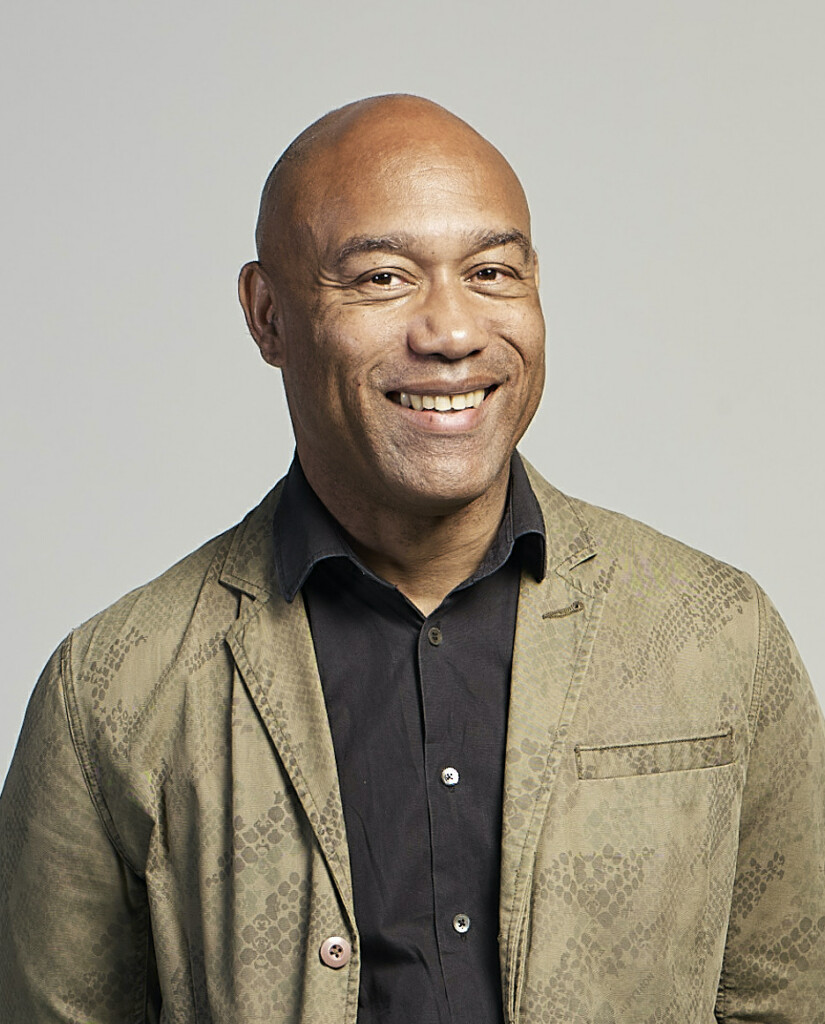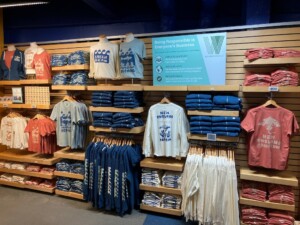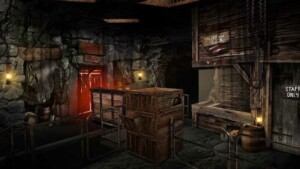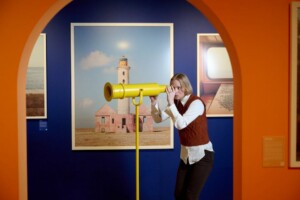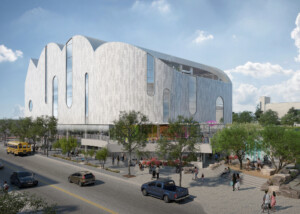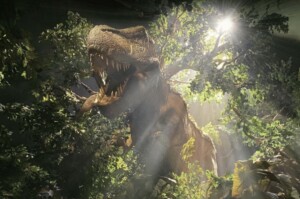The V&A East project includes the creation of a brand-new five-storey museum alongside a new collection and research centre, both located in London’s Queen Elizabeth Olympic Park, Stratford. V&A East will be part of a new culture and education centre within the park, called East Bank.
V&A East Museum has been designed by O’Donnell and Tuomey and V&A East Storehouse is an existing building that is being converted with a design by Diller Scofidio + Renfro.

Set to open to the public in 2024, V&A East Storehouse has been designed to take visitors behind the scenes. It will provide unprecedented public access to V&A collections. When completed, the 150,000-square-foot former broadcasting centre building will be home to more than 250,000 objects, 350,000 library books and 917 archives, currently stored at Blythe House in Kensington, West London.
Meanwhile, V&A East Museum, which measures around 75,000 square feet, is expected to open in 2025. It will offer welcoming spaces to socialise and, alongside two permanent collection galleries and creative studio space, it will also host major exhibitions, festivals, installations, live performances, pop-ups and more.
As work continues to progress at both sites, blooloop caught up with Dr Gus Casely-Hayford, director of V&A East and Claire McKeown, V&A East project director. Together, they spoke about the goals of the project and what visitors can expect from the new spaces.
V&A East takes shape
We last spoke to Casely-Hayford, alongside V&A deputy director Tim Reeve, in October 2020. Since then, the site has been transformed, as McKeown explains:
“Construction has been in full flow and the site looks very different now. We had the topping out of the V&A East Museum building in early 2021. Soon, we will be watertight, so that means the façade and glazing will be in place. It feels like we can get a sense of what the building’s going to be like when it’s completed. We’re also nearing completion of construction at V&A East Storehouse.
“There’s a real energy and lots of teams being appointed now to help create the finished V&A East sites.
“There have been some extreme external circumstances, from the pandemic and the conflict in Europe to high energy prices. It’s also a moment where V&A is becoming a true multi-site organisation. We’re thinking about working at a bigger scale and sharing expertise, looking at the different contexts that those different buildings give us. Those challenges have given us opportunities to think about how we work.”
Casely-Hayford adds:
“2020 feels like a long time ago! A lot has happened, both for the cultural sector and in terms of progress here. This has been one of the most challenging times, with the pandemic and the economic downturn. Yet the team has been awe-inspiring.”
The mission
V&A East is part of the V&A’s wider FuturePlan project. This will see the creation of new galleries and visitor facilities as well as restoration work on the original building in South Kensington and the transformation of the Museum of Childhood into Young V&A, which reopens in Benthal Green in summer 2023.
In terms of the team’s mission, and what makes V&A East unique, McKeown says:
“We aim to engage an audience that doesn’t typically come to museums. So, we’re looking at 16 – 35-year-olds of the same demographic makeup of the four Olympic boroughs where both our new sites are based.”

“As we’re going through all the procurement and looking at different design teams, one of the key rationales behind our decision-making is: will it engage this audience? Is it the right decision for our audience? We’ve got a strong commitment across everyone in the institution to hit that aim and to reach that target. It feels important to the area of London where we’re located. It’s also something that I think we should be aiming for as a sector as well.”
A new celebration of making
Meanwhile, in terms of content, the focus is on making; looking at the motivations behind why we make and examining the V&A’s collection through a contemporary lens.
“We want to make sure that we develop something that speaks of the V&A’s history of celebrating makers and making and great creative practice, wherever it might come from,” says Casely-Hayford.
“This is a real opportunity not just to build a great museum that speaks to all the incredible standards and heritage of the V&A, but also something that reflects contemporary needs and contemporary aspirations, and to shift our understanding of culture and demography into a greater understanding of issues of equity and sustainability.”

The V&A holds one of the world’s greatest collections. Part of the mission of V&A East is to open this up to the public:
“Moving from Blythe House to V&A East Storehouse on the Olympic Park is a chance for us to change our relationship, both with researchers and museum specialists but also with the wider public. They are, after all, the ultimate owners of our collection. This is an opportunity to give our collection back to the public. We want them to engage with it in ways that make them feel comfortable, in a space that feels very much like theirs.”
Consultation with the community
To achieve this goal, the team have made sure that they are consulting with people from across all four Olympic boroughs, from the very start of the project.
“We’ve spoken to around 30,000 people across the course of the development of this project, and at every stage,” says Casely-Hayford. “We wanted to be sure that that we aren’t making a museum just for ourselves, modelled upon what we already know.
“I would love them to feel that our spaces are theirs, but also that they can be ongoingly remade. What they will see on the first day is not a proposition that is fixed. We will be building a relationship with them. So, we can create an institution that can flex and change, that can dynamically grow in consultation with and in relation to our audiences.”

“In the last couple of years, cultural institutions have become far more aligned to the issues of equity and inclusion. If one looks back at the history of museums, they all seem to begin with this aspiration of wanting to offer universal access. But we want to not get complacent and feel that we’ve done it. We also want to constantly be evolving and asking questions. That can only happen if the levels of consultation that we’ve engaged with continue up to and beyond the opening.
“It is important that local people feel that this is a space not just where they’re reflected, but that the institution is reflexive to their contributions.”
V&A East Museum
Construction of the O’Donnell and Tuomey-designed museum is well underway. McKeown says that creating a new, purpose-built facility presents several opportunities:
“We’re able to create a public building in East London that celebrates making. That feels long overdue, considering the amount of making that has historically been done in the four boroughs. It’s also a great opportunity to make these public spaces and our collections as accessible as possible.
“From a technical point of view, we’re able to put in place infrastructure which allows us a lot of creative freedom in our programming. For instance, things like the size of the lift, the hanging points, and the weight loadings. Some of those you won’t necessarily see, but the audience benefits from the creative possibilities they give.”
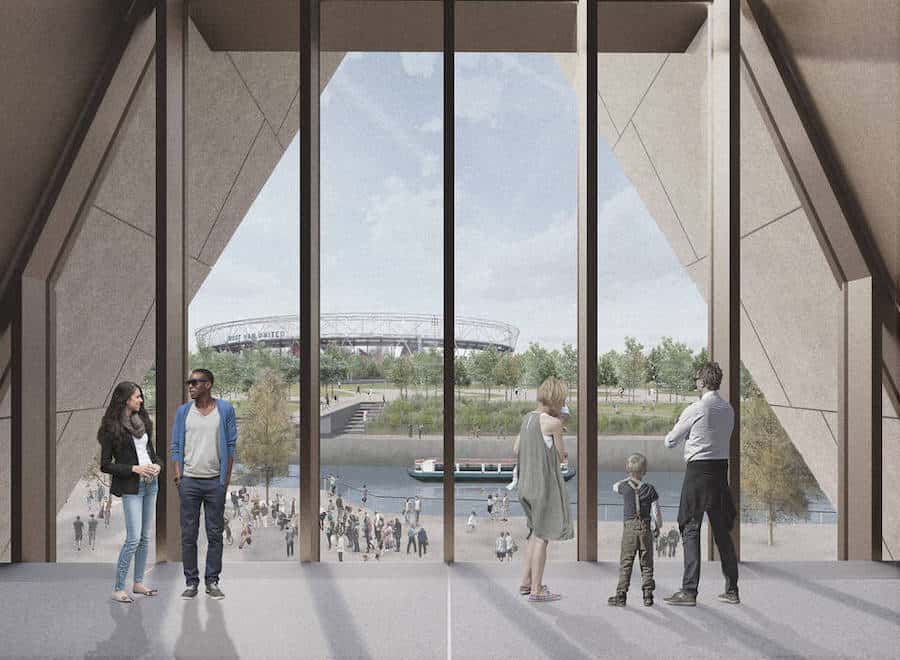
Talking about the building itself, she adds:
“The façade is now in place. One of the big advantages we had in adopting this design is that were able to play with the façade. We don’t necessarily want daylight in the gallery spaces, to protect our objects. So, we’ve got this amazing pleated and folded precast concrete façade, which looks wonderful. It’s a real statement about the importance of a cultural building and a cultural terrace within Stratford.
“Also, it celebrates the idea of bringing the V&A’s collection to East London. We’re the only East Bank building where the public can access all levels. Plus, we’ve got this amazing terrace on level four, where we can have this incredible view over London and the Olympic Park.”
Adventurous programming is planned
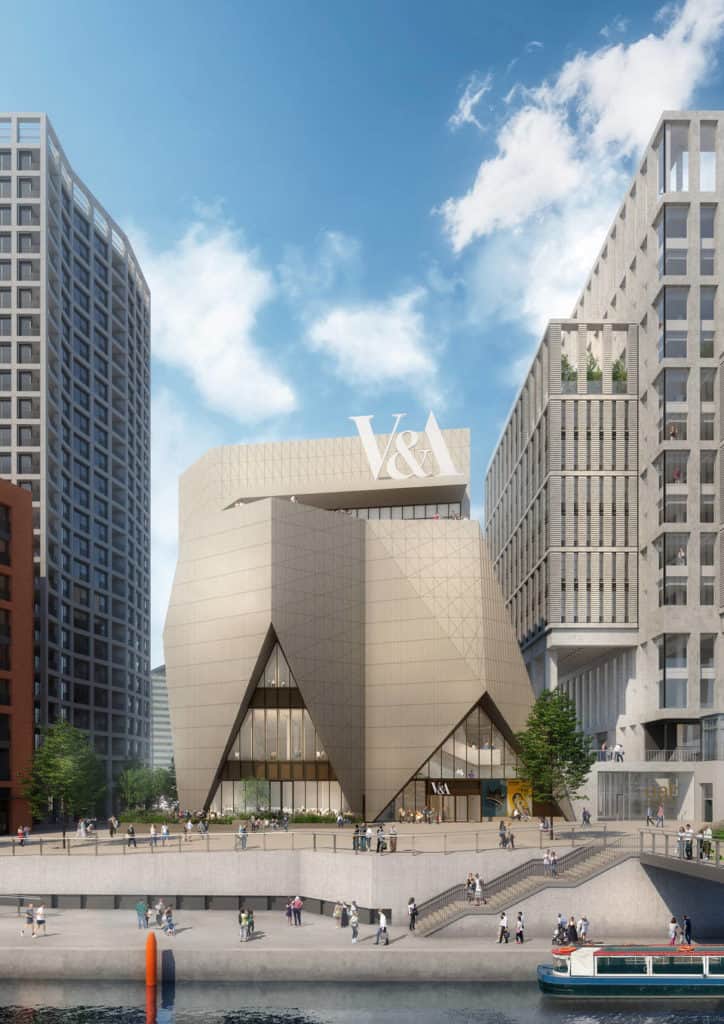
In terms of what will happen inside the building, Casely-Hayford says:
“[V&A East Museum] is a truly gorgeous building that just invites adventurous programming. The first two galleries will celebrate the permanent collection. These will be an exploration of the very best of that story, the history of making. But we also see it as an opportunity to bring those stories up into the contemporary moment through the most dynamic practices, across a range of areas.”
The goal is to make the galleries feel like an inclusive, dynamic and energised place for young, new makers.
“Then above that, we have also begun to think about what our first exhibition will be, on the next floor. We want it to be something that gives a sense of that consortium of institutions across the Olympic Park who are united in that ambition to bring the very best of making and creative practice to their institutions. There is the BBC, there is UCL with its robotics and architecture schools, there’s London College of Fashion and Sadler’s Wells. The thing that unites us is making and a drive for excellence but also a desire to make those things more accessible.”
A space in flux
Then, on the top floor, there will be an experimental space. Here, the V&A East team wants to invite people to contribute to the programme.
“We want this to be a dynamic animated response to the other things in the building. We’re just beginning some of the conversations with some of the people that we hope will come and be in residence in that space.
“Finally, we’re also thinking about propositions for the restaurant and retail spaces. We want them to chime with all the aspirations of V&A East, for us to be both local and to demonstrate connections to the very best international practice. We’re starting all those sorts of conversations. It’s an exciting time to be doing it as we come out of this period in which it’s felt like everyone has been quite insular. It’s exciting to be thinking in this more expansive way and building those connections.”

“The responses from across the sector from other museums, from artists, from designers, from industry, have been inspiring. Plus, talking to funders as well, the sorts of priorities that we have for our institution seem to chime so well with their priorities, wanting to think about issues of diversity and sustainability and to think about how we better address the needs of the young. Those are all things that we see as core to what V&A East Museum will be.”
Why We Make
One of the key milestones for the new museum was the appointment of architecture and design practice JA Projects, graphic design studio A Practice for Everyday Life and artist Larry Achiampong in August 2022. The collaborative team won a competition to design two ‘Why We Make’ gallery spaces.
The galleries will feature more than 500 objects from the V&A’s collections across 5,000 years of art, design and performance. The design team will create immersive visitor experiences as well as “quieter opportunities for contemplation”.
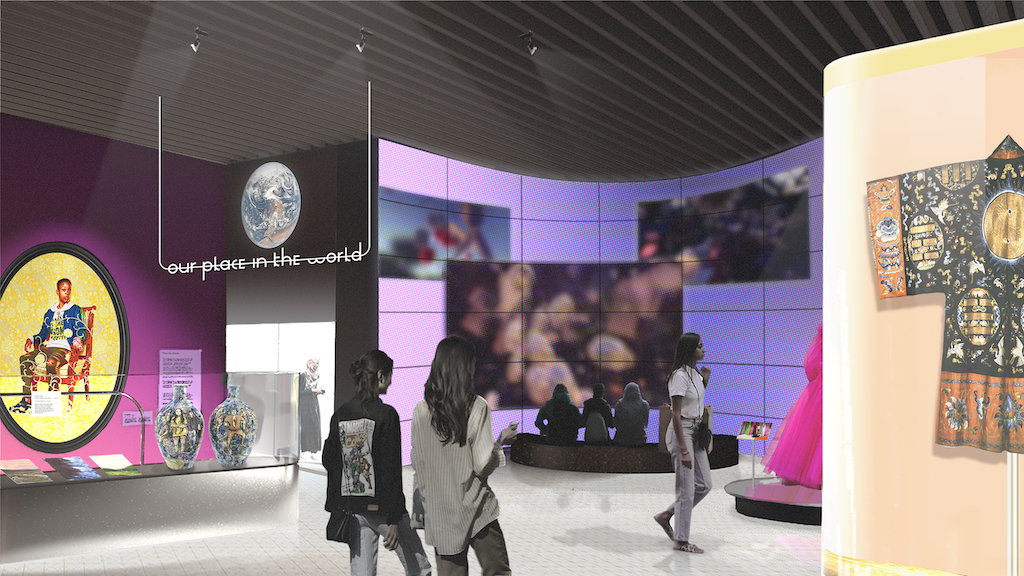
Speaking about the choice, McKeown says:
“One of our key tests for all the design work is: is it going to create a design that works for our audience? We want to look at our collection through the lens of making. Catherine Ince, our chief curator, and her team have come up with an amazing narrative for the gallery. Then, we were looking for a design team that is going to bring that alive.
“JA Project projects impressed us because it feels personal to them, they’ve got a deep personal connection to East London. They’re excited about doing a project with the V&A but also with the audience that we are aiming to target in this location. Their design has a sensitive approach to our objects and to creating different environments.
“We also wanted to work with teams that embody our vision, thinking about underrepresented groups in the industry and younger practices. We’re commissioning a lot of design now and we want to give those opportunities to East London.”
Programming at V&A East
When asked about the kind of events and programming that we might see once the V&A East Museum opens its doors, Casely-Hayford says:
“We’re not announcing our programme yet. But what I can say is that we are blessed by having this incredible campus of world-class institutions on the Olympic Park. With our first exhibition, we’ll develop something that speaks to all those different institutions and their areas of focus. We want it to showcase V&A East but also demonstrate how this wider campus is a real crucible of possibility for young people, for creatives, and for thinking about the brilliance of East London.”
“This time has taught us about both the strength and the vulnerability of the culture sector. We’ve seen how culture can be very powerful in drawing us together and we want our institution to feel like it is pulling its weight and being at the centre of a community. We want it to feel like it reflects the needs and the wants of East London but also that it can stretch out beyond that through a single programme, to impact people across the nation and then beyond.”
While he can’t reveal more details about the first exhibition just yet, he adds:
“We’ve been thoughtful in choosing something that I think will speak in powerful ways to a very wide demographic.”
V&A East Storehouse
Making the collection as accessible as possible was the core mission when designing V&A East Storehouse.
“The design for V&A East Storehouse centred around a relatively modest entrance,” explains McKeown. “But then you ascend into the collection hall itself, and there’s this incredible public space right in the heart of the collection. Wherever you are standing, it is beneath your feet, it is everywhere, in every direction you look.”
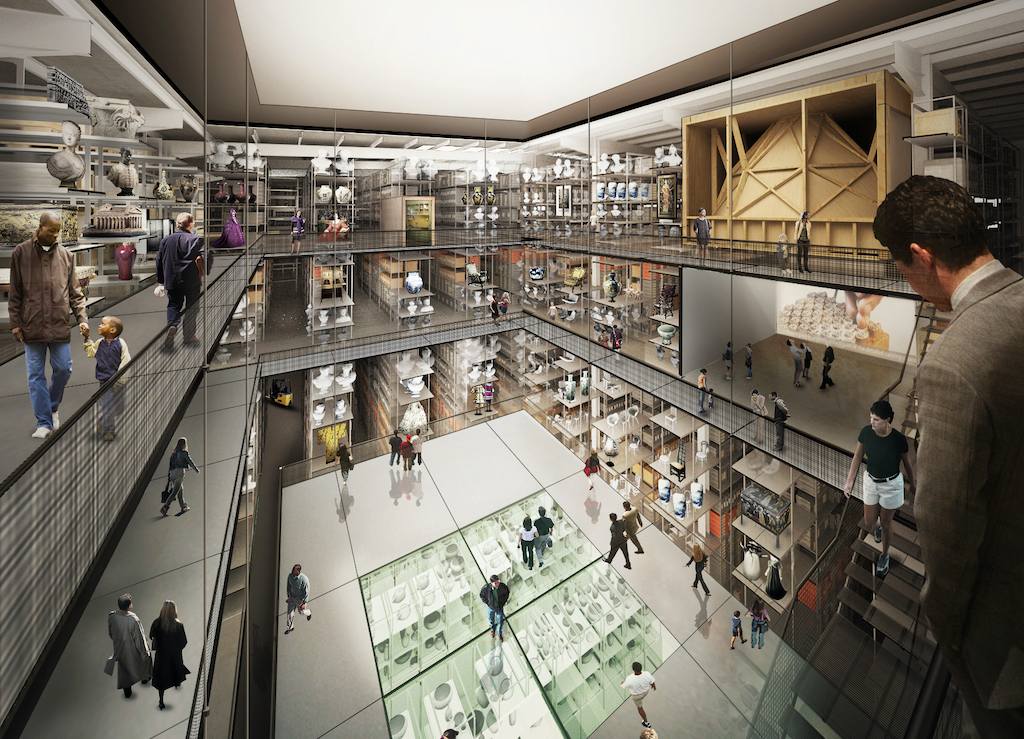
“As an intent about making our collection incredibly accessible, the design reinforces that. You’ve got this incredible visual access across the building. You can see the vastness of the collection, from our poison arrows to tapestries to clocks to fashion archives.”
“This is a working environment, a space within which all the conservation and storage work that goes on in a museum storehouse will continue, to world-class standards,” says Casely-Hayford. “But we want to open those up so that people can see them and be amongst them, so that they can interact with the museum specialists and the people who were previously behind the scenes.
“We want to give them the space to be foregrounded, both in terms of who they are and their practice.”
An accessible collection
The design, says Casely-Hayford, has resulted in a space that is open and engaging.
“We also want to extend that feeling with studio spaces, which can be used and programmed by our local communities. That will feel like an extension of our programmes but in partnership with the people who live around us, giving them opportunities to see the processes at work.
“We’ve begun that already, in taking our collections out to schools. We wanted to find a way of reaching the audiences that we want V&A East to be meaningful for. Namely, those people who don’t naturally feel comfortable in museums, the people who probably wouldn’t visit a museum in their spare time of their own volition. So, we wanted to extend the reach of our institution by going to them. We thought, where is the place where they are by necessity together? That is school, so let’s reach them in school.”
“We made a commitment to visit every single one of the secondary schools in the four boroughs. We are taking them real world-class objects, offering them things that sometimes will supplement areas of the curriculum and other times that speak more broadly, always leaving them with a sense that not only is the collection there but the space, once we open, will feel like it’s theirs.
“I hope they can find narratives and objects that will speak to their heritage, in a variety of ways, and objects that serve as sources of inspiration.”
V&A East Make Space
The team also intends to give regular access to studio space for young people living and working in East London, through its Make Space project.
“There are so many brilliant artists locally, but they need spaces where they can come and make their work,” says Casely-Hayford. “We want to give free access to studio space, to materials, to creative workshops for young people.
“We’re currently in a pilot year working with several different venues. So, we are engaging young people in the opportunity to work with some fantastic young artists and designers, and to explore their own creativity.”
“We’ve worked with people like Nicole Chui, who has previously worked with Google, Adidas and Converse. We’ve hosted illustration sessions with Sadie St Hilaire. There was a 3D lettering workshop led by Rachel Joy. These are world-class practitioners and giving young people exposure to them has been wonderful. They are engaging with young people in thinking about what their creative practice might be and talking to them in ways that they feel inspired by.
“The idea is to show young people that our spaces could be opportunities to not just do the conventional things that one might expect from a museum but to free them up to think in expansive ways about what their relationship with V&A East might be.”
Highlights from the V&A East project
The sheer scale of the project would be a challenge for any team, let alone one working through a global pandemic and a period of economic and political upheaval. Yet there have also been plenty of highlights along the way, says Casely-Hayford.

“It has been fantastic to see the secondary school programme kick off. We are getting out there with actual objects to tell the stories of what V&A East is and what it’s going to be. It’s been heartening to see the collection animated by these amazing reactions from young people.
“We’ve also continued to build our team. It’s wonderful to see the team building and to see it reflecting a younger and more diverse demographic. They are so keen for V&A East to be all it can be.
“Alongside that, I’m excited about the diversification of the collections. For instance, the acquisition of pieces like Kehinde Wiley’s ‘Portrait of Melissa Thompson’ (2020). Seeing it hanging as it is now at the V&A’s South Kensington site and imagining it as it will be at V&A East Museum is really powerful.
“There are other acquisitions too. For example, a gorgeous pair of pots that we acquired from Bisila Noha, a true superstar in the ceramics world. It’s wonderful to be building the body of our work with younger artists and craftspeople, and also to be working with audiences and artists to diversify our understanding of what we do and what we might be.”
A space for collections and people to shine
When asked what she is most looking forward to as the project progresses, McKeown says: “Loads of things! For instance, the first time I get to stand on the collection hall floor at V&A East Storehouse.
“I’m also thinking about the installation of some of the larger pieces that we’ve got within our collection. One is Robin Hood Gardens, which is a 1970s brutalist architecture facade. There’s another which is a 15th-Century gilded wooden ceiling. We’ve been doing conservation work on it, and it’s just come up beautifully, and it’s enormous. Seeing that going in will be great.”

“I’m looking forward to V&A East Museum being watertight and being able to see those spaces and get a feel of those throughout the building. I’m looking forward to it being full of objects and welcoming the first visitors.”
V&A East: a place of inspiration
Finally, Casely-Hayford reflects on his own experiences of museums, and how he hopes that the experience of future audiences will be different:
“I look back on my first museum visits and think about feeling slightly trepidatious, negotiating the entrance of these pretty inspiring institutions. I would love it if, when we open, those first visitors reflect the demography of the people that surround our institution. We want those people, as they begin to come into our spaces, to feel both a sense of ‘Gosh, isn’t this wonderful’ and they feel proud, but also that they don’t feel that this is a space within which you need to behave in a particular way, you can feel that this is truly yours.”

“I look forward to seeing the sorts of visitors that might not traditionally have felt that the museum was for them. It should feel like a space that reflects the complexity of East London and London. And, I hope it becomes a place of refuge, relaxation and inspiration.
“For it to be, over the next generation, a place within which East Londoners feel that they can come and potentially transform their professional opportunities or just come and have a good time, that would absolutely be the thing that would make me feel that I’ve done my job.”
All images kind courtesy of the Victoria and Albert Museum, London, unless otherwise stated. Top image: Internal render view of the central collection hall in V&A East Storehouse, © Diller Scofidio + Renfro, 2018

